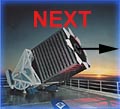H-R Diagram of a Globular Cluster
Clusters like the Pleiades lie deep within our galaxy. The SDSS, on the
other hand, looks primarily above and below the plane of the galaxy. This view
is great for seeing distant galaxies and quasars, but it is not very good for
seeing star clusters.
All of the clusters seen by the SDSS are globular clusters, thick clusters containing
millions of stars that lie just above and just below the plan of our galaxy.
The two clusters we'll work with were both found by the Palomar Sky Survey
in the 1950's, hence the names Pal 3 and Pal 5. Their coordinates are given below.
Name |
Ra |
Dec |
Radius |
Pal 3 |
151.3801 |
0.072 |
0.7 arcmin |
Pal 5 |
229.0128 |
-0.1082 |
3 arcmin |
Below you can see pictures of Pal 3 and Pal 5.
These pictures are here to help you orient yourself, so you can be sure you
are seeing the correct clusters in the Navigation tool. If you would like to
look up the original Palomar Sky Survey pictures of these clusters, you may
do so by clicking
here to
use a form to download a .fits or .gif image. Simply enter Pal 3 or Pal 5 in the
field labeled "object name," then follow the instructions.
Pal 3
You can see the cluster on the bottom left of the image.

|
Click on the image to launch the Navigation tool |
Pal 5
Pal 5 is a much larger cluster. It is between the two brightest
objects in this image.

|
Click on the image to launch the Navigation tool |
The SDSS uses slightly different filters than the traditional b, v, and
r filters, so when you make your H-R diagram, you can't use the traditional b-v
color. Instead, use the g and r filters, which happen to lie in the visible
part of the spectrum, to calculate g-r color for your H-R diagram.
Exercise 6.
Use the
Navigation Tool to make an H-R diagram of Palomar 5. When you click the
link, the tool will open in a new window. You will see a screen like this:

Enter the coordinates for Pal 5 (RA = 229.0128, Dec = -0.1082) and click
"Get Image." Pal 5 will appear in the main window. You can zoom in or out
in the image with the zoom bar below Get Image. Click the plus sign to zoom in or the minus sign to
zoom out. You can also move around in the sky by clicking the NWSE buttons
around the image.
When you click on any star in the image, a green square
will come up around it. A close-up of the object will appear in the top right,
and the object's data will appear at the right. Click "Add to Notes" to save the
star's data in your notebook.
When you finish choosing stars and saving them to your notebook, save your entire notebook
to your computer. To do that, click on the radio button next to "CSV," then click the "Export" button
to download the data as CSV (comma-separated value). You can then open the CSV file in any
graphing program, including Excel.
Use the data to make an H-R diagram of the globular cluster.
Put the r magnitude on the y-axis and the g-r color on the x-axis.
Try to take stars only from the cluster. Stars that appear
dramatically different may be at different distances along the same line of
sight. You should also be careful not to accidentally
record the information for a galaxy. Try to get at least 20 to
30 stars for your diagram. |
Question 10.
What type(s) of stars do you see on this H-R diagram? What
types of stars do you not see? |
Question 11. Why don't you see all types of stars in this
cluster? (Hint : Could it be due to a limitation imposed by our
equipment?) |
|


